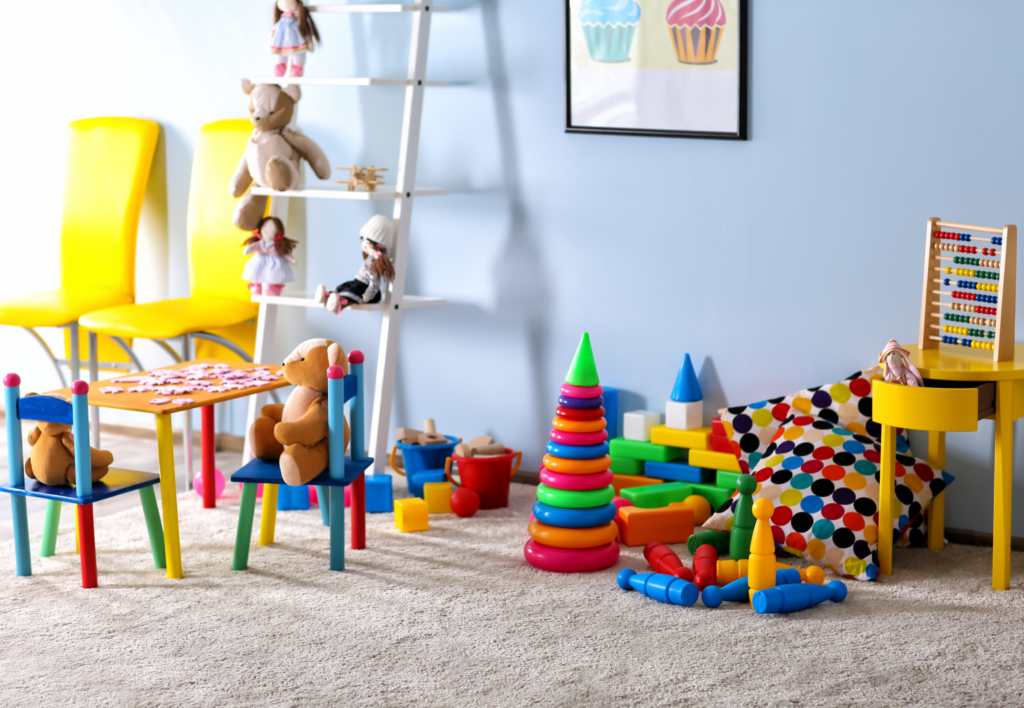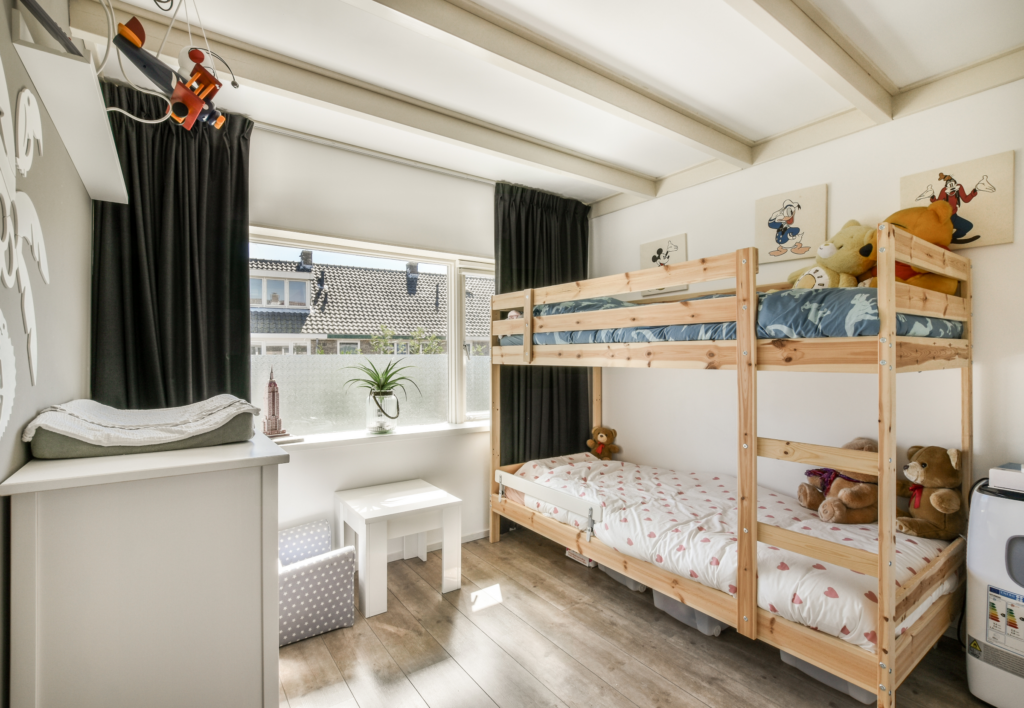10 Creative SHARED Bedroom Ideas for Siblings of Different Ages
Creating a shared bedroom for siblings of different ages can be a delightful challenge. It’s not just about finding a middle ground between the interests and needs of each child but also about crafting a space that can adapt and grow with them. The key is to strike a balance between functionality and personal expression, ensuring that each child feels at home in the shared space.
In this post, we’ll explore 10 creative ideas that can help you design a shared room that both your toddler and your tween will love. From defining individual spaces to selecting the right color palette, these tips are designed to inspire fun, foster sibling harmony, and provide practical solutions for your family’s unique needs.
1. Define Individual Spaces Within the Shared Room
Why This Works: Personal space is a crucial element for children, especially when they are sharing a room with a sibling. It allows them to feel a sense of ownership and privacy within the shared environment.
Fun Ideas:
- Use bookshelves as room dividers that provide privacy and storage.
- Install a ceiling-mounted curtain that can be easily drawn to separate the space when needed.
- Consider using different area rugs to visually demarcate each sibling’s territory.
Quick Tips:
- Let each child choose their side of the room or specific elements within their space to reflect their personality.
- Ensure that each child has a say in the design process, which can help prevent disputes and foster a sense of belonging.

2. Choose a Flexible, Neutral Color Palette
Why This Works: A neutral color palette serves as a blank canvas that can easily adapt to changing tastes and age-related transitions. It’s timeless and can accommodate both a nursery theme and a more sophisticated look for older children.
Fun Ideas:
- Select wall colors like soft grays, beiges, or pastels that can match a variety of decor styles.
- Add pops of color through wall art, bedding, and accessories that each child can pick out themselves.
Quick Tips:
- Use removable wall decals or stickers that can be easily updated or changed as the children grow.
- Incorporate textures through curtains, pillows, and rugs to add depth and interest to the room without relying heavily on color.
3. Invest in Age-Appropriate, Multi-functional Furniture
Why This Works: Furniture that serves multiple purposes not only saves space but also offers long-term functionality as your children’s needs evolve over time.
Fun Ideas:
- Choose a crib that can convert into a toddler bed for the younger sibling.
- Opt for a loft bed with a desk or play area underneath for the older sibling, maximizing floor space.
Quick Tips:
- Look for dressers or storage units with adjustable interior components that can be reconfigured as storage needs change.
- Consider furniture with built-in charging stations or tech-friendly features for older children’s gadgets and study needs.
4. Create a Shared Play Area
Why This Works: A shared play area promotes cooperative play and gives siblings a chance to bond over shared interests, regardless of their age difference. It’s a space that encourages imagination and collective enjoyment.
Fun Ideas:
- Designate a corner of the room for playtime, equipped with a comfortable rug and storage bins for toys.
- Introduce a small table and chairs where siblings can engage in arts and crafts together.
- Include a variety of games and toys that cater to both age groups, like building blocks and puzzles.
Quick Tips:
- Use open shelving units to store toys, making it easy for both siblings to access and put away their playthings.
- Rotate toys regularly to keep the shared play area fresh and engaging for both children.

5. Implement Creative Storage Solutions
Why This Works: Good storage is essential in any shared space. It helps keep the room organized and clutter-free, giving each child space to store their belongings separately.
Fun Ideas:
- Use multi-colored storage bins or baskets to assign a color for each sibling’s personal items.
- Install floating shelves at varying heights so each child can easily reach their own things.
Quick Tips:
- Label drawers and bins with pictures or words to help younger children know where to put their items.
- Encourage the children to take part in organizing their space, which can also teach them responsibility and tidiness.
6. Designate Personalized Display Areas
Why This Works: Giving each sibling a place to display their favorite things can help them feel valued and respected in their shared room. It’s a way for them to express their individuality and showcase their achievements.
Fun Ideas:
- Create a gallery wall where each sibling can hang their favorite artwork or posters.
- Provide each child with a magnetic or cork board to pin up photos, drawings, and notes.
Quick Tips:
- Make sure the display areas are easily changeable so that the children can update their displays as they grow and their interests evolve.
- Position the display areas so that they are personal but also contribute to the overall aesthetic of the room.
7. Opt for Adaptable Bedding Options
Why This Works: Bedding can be a simple and cost-effective way to cater to each child’s age and preferences. Adaptable bedding options allow for easy updates as children grow and their tastes change.
Fun Ideas:
- Choose duvet covers that can be easily swapped out for different patterns or characters as interests evolve.
- Consider using bed tents or canopies for younger children to create a sense of adventure and privacy within the shared room.
Quick Tips:
- Invest in high-quality, neutral bedding as a base layer that can last through various style changes.
- Encourage each child to select their own throw pillows or stuffed animals to personalize their bed space.

8. Set Up a Shared Study Corner
Why This Works: A shared study space encourages siblings to work on homework or creative projects together, fostering a collaborative atmosphere. It can also help maximize the use of the room by creating a multifunctional area.
Fun Ideas:
- Install a long desk with space for two chairs, allowing siblings to study side by side.
- Add a chalkboard or whiteboard wall for doodling and practicing lessons.
Quick Tips:
- Provide each child with their own set of supplies and storage to keep their work organized.
- Ensure adequate lighting for both siblings, with individual task lights if necessary.
9. Incorporate Durable and Easy-to-Clean Materials
Why This Works: Durable materials are a practical choice for a children’s shared room, where wear and tear are more likely. Easy-to-clean surfaces make maintenance simpler and help the room stay neat.
Fun Ideas:
- Use washable paint and stain-resistant fabrics to keep the room looking fresh.
- Choose rugs and carpets that are easy to vacuum and spot clean.
Quick Tips:
- Select furniture with smooth, wipeable surfaces to make cleaning up spills a breeze.
- Consider slipcovers for chairs and sofas that can be removed and laundered.
10. Encourage Sibling Bonding with Collaborative Decor Projects
Why This Works: Collaborative projects can strengthen the sibling relationship by providing opportunities for teamwork and shared decision-making. When siblings work together to create something for their room, it fosters a sense of pride and co-ownership.
Fun Ideas:
- Plan a DIY room decor day where siblings can make art or decorations for their room together.
- Set up a “room planning” session where they can brainstorm and decide on new themes or rearrangements.
Quick Tips:
- Choose projects that are age-appropriate and safe for both siblings to participate in.
- Encourage each child to contribute ideas and respect their decisions to ensure the project is truly collaborative.
Conclusion
Designing a shared room for siblings of different ages doesn’t have to be a daunting task. With a bit of creativity and strategic planning, you can create a space that meets the needs of both children and evolves with them as they grow.
By defining individual spaces, choosing a flexible color palette, and investing in multi-functional furniture, you can maximize the room’s potential.
Encouraging play, providing ample storage, and allowing personal expression through display areas can make the room comfortable and enjoyable for siblings to share. Adaptable bedding, a communal study corner, and durable materials ensure that the room is both practical and inviting. Lastly, engaging siblings in collaborative decor projects can strengthen their bond and make them feel equally invested in their shared space.
Remember, the goal is to design a room that reflects each child’s uniqueness while also being a testament to their shared experiences. By involving your children in the decorating process, you can ensure that their shared room is a place they both cherish and enjoy.
Let Us Know How We’re Doing!
Did this expertly prepared resource answer your question?
Do you have another question about home maintenance, home improvement projects, home appliance repair, or something else?
Get more information, send in questions and keep the discussion going by contacting the I’ll Just Fix It Myself company customer service team at at 1-800-928-1490 or Email us at [email protected]
